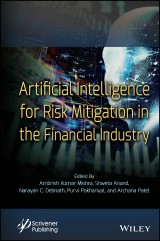Details
Artificial Intelligence for Risk Mitigation in the Financial Industry
1. Aufl.
|
168,99 € |
|
| Verlag: | Wiley |
| Format: | |
| Veröffentl.: | 20.05.2024 |
| ISBN/EAN: | 9781394175567 |
| Sprache: | englisch |
| Anzahl Seiten: | 384 |
DRM-geschütztes eBook, Sie benötigen z.B. Adobe Digital Editions und eine Adobe ID zum Lesen.
Beschreibungen
<b>Artificial Intelligence for Risk Mitigation in the Financial Industry</b> <p> <b>This book extensively explores the implementation of AI in the risk mitigation process and provides information for auditing, banking, and financial sectors on how to reduce risk and enhance effective reliability</b>. <p>The applications of the financial industry incorporate vast volumes of structured and unstructured data to gain insight into the financial and non-financial performance of companies. As a result of exponentially increasing data, auditors and management professionals need to enhance processing capabilities while maintaining the effectiveness and reliability of the risk mitigation process. The risk mitigation and audit procedures are processes involving the progression of activities to “transform inputs into output.” As AI systems continue to grow mainstream, it is difficult to imagine an aspect of risk mitigation in the financial industry that will not require AI-related assurance or AI-assisted advisory services. AI can be used as a strong tool in many ways, like the prevention of fraud, money laundering, and cybercrime, detection of risks and probability of NPAs at early stages, sound lending, etc. <p><b>Audience</b> <p>This is an introductory book that provides insights into the advantages of risk mitigation by the adoption of AI in the financial industry. The subject is not only restricted to individuals like researchers, auditors, and management professionals, but also includes decision-making authorities like the government. This book is a valuable guide to the utilization of AI for risk mitigation and will serve as an important standalone reference for years to come.
<p><b>Ambrish Kumar Mishra, PhD, </b> is a scholar in the School of Management at Gautam Buddha University in Greater Noida, Uttar Pradesh, India. He obtained his Master’s in banking services from Amity University Noida, India in 2014, and has spent six years in the banking industry teaching and as a mutual fund and GST trainer with the BFSI sector skill council in India. He has published research papers and received various awards in his field of research. <p><b>Shweta Anand, PhD, </b> is the dean of the School of Management at Gautam Buddha University in Greater Noida, Uttar Pradesh, India. She earned a PhD in Wealth Management and has 30+ years of experience of which 14 years were in industry. She has won several awards and accolades and has published numerous papers in international and national journals and conferences. <p><b>Narayan C. Debnath, PhD, </b> is the Founding Dean of the School of Computing and Information Technology at Eastern International University (EIU), Vietnam where he also serves as the Head of the Department of Software Engineering. He has been the Director of the International Society for Computers and their Applications (ISCA), USA since 2014 as well as serving as a Full Professor of Computer Science at Winona State University, Minnesota, USA for 28 years. He is the author or co-author of more than 500 publications in numerous refereed journals and conference proceedings as well as the editor of several books. <p><b>Purvi Pokhariyal, PhD, </b> is the Campus Director at the National Forensic Sciences University of the Delhi Campus, India. She has more than 25 years of academic and industry experience in the field of law and justice administration. She has published about 50 papers in national and international journals and conferences. <p><b>Archana Patel, PhD, </b> is an assistant professor at the National Forensic Sciences University, Delhi, India. She completed her PhD in Computer Applications and a PG degree from the National Institute on Technology in Kurukshetra, India in 2020 and 2016, respectively. Dr. Patel has received various awards for her presentation of research work, and published more than 40 papers in peer-reviewed journals and conferences, as well as edited 10 books. Her research interests are in ontological engineering, semantic web, big data, expert systems, and knowledge warehouses.
<p> <b>This book extensively explores the implementation of AI in the risk mitigation process and provides information for auditing, banking, and financial sectors on how to reduce risk and enhance effective reliability</b>. <p>The applications of the financial industry incorporate vast volumes of structured and unstructured data to gain insight into the financial and non-financial performance of companies. As a result of exponentially increasing data, auditors and management professionals need to enhance processing capabilities while maintaining the effectiveness and reliability of the risk mitigation process. The risk mitigation and audit procedures are processes involving the progression of activities to “transform inputs into output.” As AI systems continue to grow mainstream, it is difficult to imagine an aspect of risk mitigation in the financial industry that will not require AI-related assurance or AI-assisted advisory services. AI can be used as a strong tool in many ways, like the prevention of fraud, money laundering, and cybercrime, detection of risks and probability of NPAs at early stages, sound lending, etc. <p><b>Audience</b> <p>This is an introductory book that provides insights into the advantages of risk mitigation by the adoption of AI in the financial industry. The subject is not only restricted to individuals like researchers, auditors, and management professionals, but also includes decision-making authorities like the government. This book is a valuable guide to the utilization of AI for risk mitigation and will serve as an important standalone reference for years to come.



















